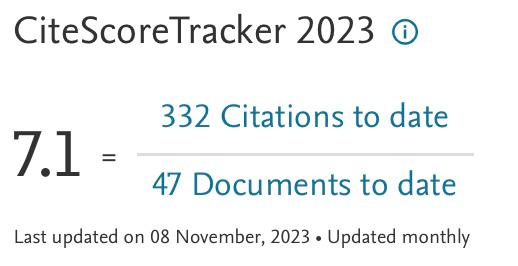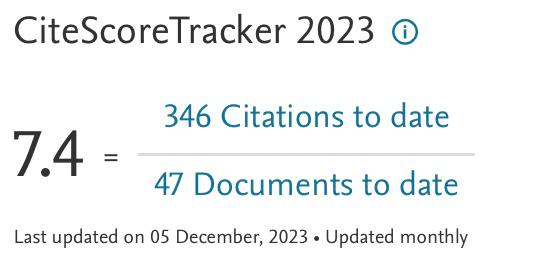Evaluation of Virus Concentration Analysis in the Airway by CFD
DOI:
https://doi.org/10.37934/arnht.13.1.96105Keywords:
Airway, Virus Concentration, Risk Evaluation, CFDAbstract
Currently, Covid-19 is an epidemic all over the world. When virus directly adhere to mucous membrane of airway by breath, some humans maybe get inflammatory responses by viruses in the first stage of infection. The airway is composed of the nasal cavity, sinuses (Maxillary Sinus, Ethmoid Sinus, Frontal Sinus and Sphenoidal Sinus) and lungs. In the infection stage, the sinuses located in the nasal cavity tend to exhibit particularly high virus concentrations. Therefore, it is important to evaluate quantitatively the areas where viruses are likely to be adhered in the nasal cavity including sinuses. In this study, by CFD including concentration analysis the areas where viruses are likely to be adhered in the nasal cavity are predicted. As for the methods, the nasal cavity was made from 2D-CT image data by Itk-SNAP. For this computation in the nasal cavity continuity equation, Navier-Stokes equation and transport equation are used. And the transport of concentration was computed in the divided 4 parts of nasal cavity. As a result, it was found that the ratio of the concentration to the initial concentration in Ethmoid Sinus is approximately 0.6. It was found that Ethmoid Sinus is the areas where viruses are likely to be adhered and the areas can be predicted by computing the concentration.
Downloads
References
Zhu, Na, Dingyu Zhang, Wenling Wang, Xingwang Li, Bo Yang, Jingdong Song, Xiang Zhao et al. "A novel coronavirus from patients with pneumonia in China, 2019." New England journal of medicine 382, no. 8 (2020): 727-733. https://doi.org/10.1056/NEJMoa2001017
Wang, Chen, Peter W. Horby, Frederick G. Hayden, and George F. Gao. "A novel coronavirus outbreak of global health concern." The lancet 395, no. 10223 (2020): 470-473. https://doi.org/10.1016/S0140-6736(20)30185-9
Zuber, Mohammad, John Valerian Corda, Milad Ahmadi, B. Satish Shenoy, Irfan Anjum Badruddin, Ali E. Anqi, Kamarul Arifin Ahmad et al. "Investigation of coronavirus deposition in realistic human nasal cavity and impact of social distancing to contain COVID-19: A computational fluid dynamic approach." Computer Modeling in Engineering & Sciences 125, no. 3 (2020): 1185-1199. https://doi.org/10.32604/cmes.2020.015015
Schroeter, Jeffry D., Julia S. Kimbell, Bahman Asgharian, Earl W. Tewksbury, and Madhuri Singal. "Computational fluid dynamics simulations of submicrometer and micrometer particle deposition in the nasal passages of a Sprague-Dawley rat." Journal of aerosol science 43, no. 1 (2012): 31-44. https://doi.org/10.1016/j.jaerosci.2011.08.008
Li, Xiangdong, Kiao Inthavong, and Jiyuan Tu. "Particle inhalation and deposition in a human nasal cavity from the external surrounding environment." Building and Environment 47 (2012): 32-39. https://doi.org/10.1016/j.buildenv.2011.04.032
Mortazavi, Hamed, Hamidreza Mortazavy Beni, Fatemeh Aghaei, and Seyed Hossein Sajadian. "SARS-CoV-2 droplet deposition path and its effects on the human upper airway in the oral inhalation." Computer Methods and Programs in Biomedicine 200 (2021): 105843. https://doi.org/10.1016/j.cmpb.2020.105843
Inthavong, Kiao, Jiawei Ma, Yidan Shang, Jingliang Dong, Annicka SR Chetty, Jiyuan Tu, and Dennis Frank-Ito. "Geometry and airflow dynamics analysis in the nasal cavity during inhalation." Clinical Biomechanics 66 (2019): 97-106. https://doi.org/10.1016/j.clinbiomech.2017.10.006
Yu, Shen, Danqing Wang, Yan Guo, Shuang Shen, and Jizhe Wang. "Numerical study on the distribution of nitric oxide concentration in the nasal cavity of healthy people during breathing." Nitric Oxide 130 (2023): 12-21. https://doi.org/10.1016/j.niox.2022.11.002
Corda, John Valerian, B. Satish Shenoy, Leslie Lewis, S. M. Khader, Kamarul Arifin Ahmad, and Mohammad Zuber. "Nasal airflow patterns in a patient with septal deviation and comparison with a healthy nasal cavity using computational fluid dynamics." Frontiers in Mechanical Engineering 8 (2022): 1009640. https://doi.org/10.3389/fmech.2022.1009640
Wedel, Jana, Paul Steinmann, Mitja Štrakl, Matjaž Hriberšek, and Jure Ravnik. "Can CFD establish a connection to a milder COVID-19 disease in younger people? Aerosol deposition in lungs of different age groups based on Lagrangian particle tracking in turbulent flow." Computational Mechanics 67 (2021): 1497-1513. https://doi.org/10.1007/s00466-021-01988-5
Basu, Saikat. "Computational characterization of inhaled droplet transport to the nasopharynx." Scientific Reports 11, no. 1 (2021): 6652. https://doi.org/10.1038/s41598-021-85765-7
Brüning, Jan, Thomas Hildebrandt, Werner Heppt, Nora Schmidt, Hans Lamecker, Angelika Szengel, Natalja Amiridze et al. "Characterization of the airflow within an average geometry of the healthy human nasal cavity." Scientific reports 10, no. 1 (2020): 3755. https://doi.org/10.1038/s41598-020-60755-3
Yushkevich, Paul A., Joseph Piven, Heather Cody Hazlett, Rachel Gimpel Smith, Sean Ho, James C. Gee, and Guido Gerig. "User-guided 3D active contour segmentation of anatomical structures: significantly improved efficiency and reliability." Neuroimage 31, no. 3 (2006): 1116-1128. https://doi.org/10.1016/j.neuroimage.2006.01.015
Corley, Richard A., Senthil Kabilan, Andrew P. Kuprat, James P. Carson, Kevin R. Minard, Richard E. Jacob, Charles Timchalk et al. "Comparative computational modeling of airflows and vapor dosimetry in the respiratory tracts of rat, monkey, and human." Toxicological Sciences 128, no. 2 (2012): 500-516. https://doi.org/10.1093/toxsci/kfs168
Qu, Guangbo, Xiangdong Li, Ligang Hu, and Guibin Jiang. "An imperative need for research on the role of environmental factors in transmission of novel coronavirus (COVID-19)." (2020): 3730-3732. https://doi.org/10.4164/sptj.57.526
White, Nathan, John-David Seelig, and Sudarshan K. Loyalka. "Computation of drag and diffusion coefficient for coronavirus: I." Journal of Aerosol Science 157 (2021): 105806. https://doi.org/10.1016/j.jaerosci.2021.105806



























